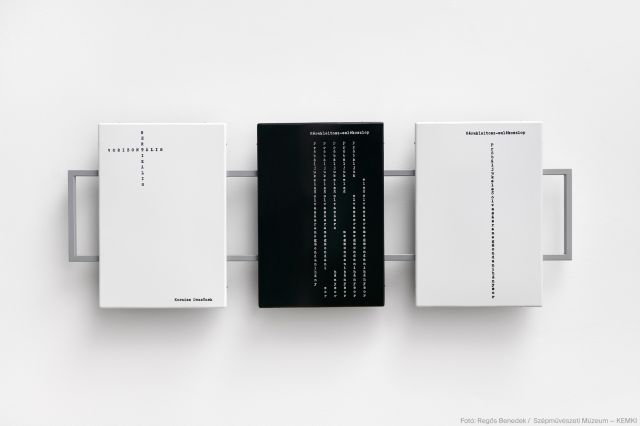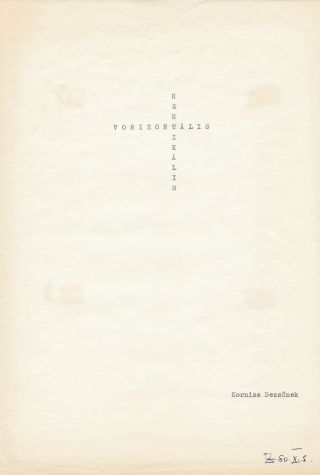ALBERT Ádám: My Appropriations (Dezső Tandori), 2022
3 equal-sized enamel panels, 44 x x30 cm / each, mounted on hollow structural section
overall dimensions: 44 x 120 cm
The works of Dezső TANDORI (1938–2019), along with his letters to Dezső KORNISS (1908–1984), have been entrusted to the care of the KEMKI ADK by the Hungarian National Bank. The manuscript pages used for the enamel triptych (1980) contain Tandori’s typed calligrams – the VORIZONTAL-HERTICAL (KEMKI ADK Inv. No. MNB.ADT.2017.2.198.1) and two versions of the Heraclitus Memorial Column (KEMKI ADK Inv. No. MNB.ADT.2017.2.262.2, 3)[1].
“The Heraclitus motif shows up several times. In my first Heraclitus piece (from 1968) the text representing the only vertical column reads ‘let’s try to tell on first reading how many lines there are’. What makes this Heraclitian is the fact that, by the time the readers—viewers—know what their task is, they cannot actually perform it, because it’s too late: they should have determined the number of lines upon first reading. According to Heraclitus, however, one cannot step into the same river twice, etc. Now, eleven years later (...) I have made an addition to the memorial column: it now has six columns of text, and none of them is a complete, each vertical line is missing a word. This makes the task setting even more absolute.”[2] These lines by Tandori appear in a catalogue of his 1981 exhibition held in Hatvan, in which Korniss also participated. Of the calligrams contained in the correspondence from 1980, however, only the third calligram was included in this exhibition, whose “theme” centres on one of the key works of the master’s late period, the painting series entitled Horizontal-Vertical (1975–1977). Tandori reflects with gentle and empathetic irony on the ascetic reduction of form and colour evident in these works, which were also presented within the framework of his 1983 memorial exhibition at the Hungarian National Gallery [3], and which, according to Lóránd Hegyi, could also be regarded as a manifestation of visual sign creation articulating Tandori’s ars poetica [4]. The series is visualized by adopting the shape of the cross motif, and reproduced in a “mistyped” form, turning it into a “picture poem”: VORIZONTAL-HERTICAL.
Albert arranges the three enamel panels in a row, around the raining letters of the “broader” Heraclitus memorial column—turned into its negative: black on white—reminiscent of matrix code. The interconnected architectural constructs of the calligram structures, along with the sensuous, monochrome minimalism of the overall effect, simultaneously commemorate and invoke this mutually inspiring teacher-student relationship.
[1] The poems are published in Dezső Tandori: A feltételes megálló (versek 1976-1980) [Conditional Stop (Poems 1976-1980)]. Magvető Könyvkiadó, Budapest, 1983, URL: https://reader.dia.hu/document/Tandori_Dezso-A_felteteles_megallo-13793
[2] Dezső Tandori: no title. In Hérakleitosz H-ban. Tandori Dezső kiállítás a Hatvany Lajos Múzeumban 1981 [Heraclitus in H: Dezső Tandori’s Exhibition at the Lajos Hatvany Museum, 1981], Hatvani Lajos Múzeum fűzetei No 9, edited by Ákos Kovács, Hatvan, 1981, 7.
[3] Korniss Dezső kiállítása, Magyar Nemzeti Galéria, Budapest, 1980. március – május [Exhibition of Dezső Korniss, Hungarian National Gallery, Budapest, March – May 1980]. (Exhibition catalogue, ed. Lóránd Hegyi, curated by István Dévényi and Lóránd Hegyi), 57–58.
[4] Lóránd Hegyi: Korniss Dezső. Képzőművészeti Kiadó, Budapest, 1982, 156–162.



